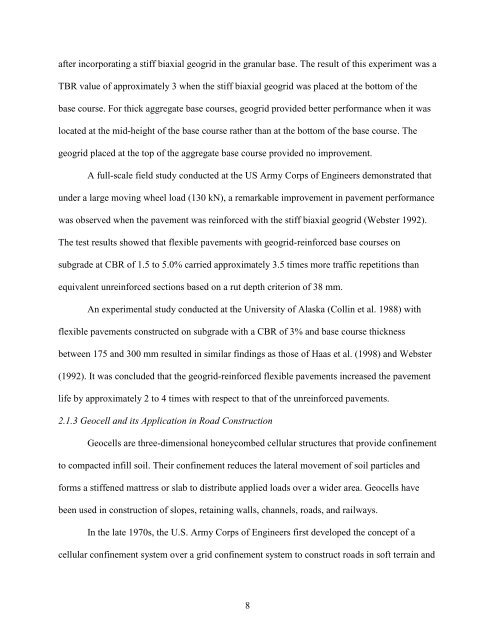Onsite Use of Recycled Asphalt Pavement Materials and Geocells to ...
Onsite Use of Recycled Asphalt Pavement Materials and Geocells to ...
Onsite Use of Recycled Asphalt Pavement Materials and Geocells to ...
Create successful ePaper yourself
Turn your PDF publications into a flip-book with our unique Google optimized e-Paper software.
after incorporating a stiff biaxial geogrid in the granular base. The result <strong>of</strong> this experiment was a<br />
TBR value <strong>of</strong> approximately 3 when the stiff biaxial geogrid was placed at the bot<strong>to</strong>m <strong>of</strong> the<br />
base course. For thick aggregate base courses, geogrid provided better performance when it was<br />
located at the mid-height <strong>of</strong> the base course rather than at the bot<strong>to</strong>m <strong>of</strong> the base course. The<br />
geogrid placed at the <strong>to</strong>p <strong>of</strong> the aggregate base course provided no improvement.<br />
A full-scale field study conducted at the US Army Corps <strong>of</strong> Engineers demonstrated that<br />
under a large moving wheel load (130 kN), a remarkable improvement in pavement performance<br />
was observed when the pavement was reinforced with the stiff biaxial geogrid (Webster 1992).<br />
The test results showed that flexible pavements with geogrid-reinforced base courses on<br />
subgrade at CBR <strong>of</strong> 1.5 <strong>to</strong> 5.0% carried approximately 3.5 times more traffic repetitions than<br />
equivalent unreinforced sections based on a rut depth criterion <strong>of</strong> 38 mm.<br />
An experimental study conducted at the University <strong>of</strong> Alaska (Collin et al. 1988) with<br />
flexible pavements constructed on subgrade with a CBR <strong>of</strong> 3% <strong>and</strong> base course thickness<br />
between 175 <strong>and</strong> 300 mm resulted in similar findings as those <strong>of</strong> Haas et al. (1998) <strong>and</strong> Webster<br />
(1992). It was concluded that the geogrid-reinforced flexible pavements increased the pavement<br />
life by approximately 2 <strong>to</strong> 4 times with respect <strong>to</strong> that <strong>of</strong> the unreinforced pavements.<br />
2.1.3 Geocell <strong>and</strong> its Application in Road Construction<br />
<strong>Geocells</strong> are three-dimensional honeycombed cellular structures that provide confinement<br />
<strong>to</strong> compacted infill soil. Their confinement reduces the lateral movement <strong>of</strong> soil particles <strong>and</strong><br />
forms a stiffened mattress or slab <strong>to</strong> distribute applied loads over a wider area. <strong>Geocells</strong> have<br />
been used in construction <strong>of</strong> slopes, retaining walls, channels, roads, <strong>and</strong> railways.<br />
In the late 1970s, the U.S. Army Corps <strong>of</strong> Engineers first developed the concept <strong>of</strong> a<br />
cellular confinement system over a grid confinement system <strong>to</strong> construct roads in s<strong>of</strong>t terrain <strong>and</strong><br />
8
















